The harvesting of the sun’s power has increased in popularity to a point where an inspection or installation of a solar application is probably not new to many. The Interstate Renewable Energy Council (IREC) reports that “Over 124,000 new solar heating, cooling, and solar electric installations were completed in 2010, an increase of 22% compared to the number of systems installed in 2009. The capacity of these installations is 981 MWDC for electricity production and 814 MWTH for thermal heating. The majority of the market share for each solar technology is concentrated in a few states. However, the number of states with a significant number of installations is growing.” If you haven’t seen a PV installation yet, rest assured that the likelihood of your being on a PV site is imminent.
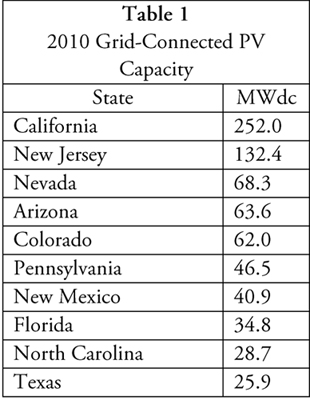
Table 1. 2010 grid-connected PV capacity
The market activity in PV has driven many new products into our markets, making the inspector’s job difficult as technology can change from one job to the next. You will be faced with new products and configurations that will require you to do your homework. A heightened sense of awareness is an asset in this changing market. Products are changing faster than the codes and standards that govern them. You must be prepared and well-read on this topic.
The Solar Market
The solar market is growing by leaps and bounds here in the United States, with California and New Jersey leading the pack with respect to grid-connected solar installations (table 1). California, for 2010, had an installed grid-connected capacity of 252 MW of dc power. On the complete opposite side of the country, for that same year, New Jersey came in second at a whopping 132.4 MW of grid connected dc power. These two states are leading the charge in grid-connected solar which has grown in the United States, in 2010 alone, by 62% to 606 MWdc. As shown in table 1, the top 10 states are not necessarily located in one specific geographical area.
California and New Jersey may be leading the pack on an installed base playing field, but Nevada and New Mexico had a PV explosion occur that drove their connected grid MW of dc through the roof. These states grew from 2.5 MWdc and 1.4 MWdc to 68.3 MWdc and 40.9 MWdc, respectively. That is an outstanding growth and if you live and inspect or install in these states, you were in the middle of it.
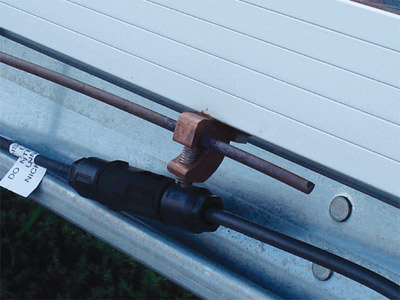
Photo 1. Example of corrosion build-up due to dissimilar metals
The PV market, without a doubt, has exploded across the United States. The impetus for this growth is government subsidies and tax rebates. As I write, headlines are showing some of these subsidies drying up and some solar corporations closing shop. This type of activity may cause one to wonder if PV has the momentum to keep on trucking as the return on investment for these installations are not quite as attractive without these government rebates. As the cost of components for PV installations comes down, it is quite possible that a non-government subsidized market could be in our future. One thing is for sure, our markets have the parts and pieces and experience to get a PV system up and running. The do-it-yourselfers are armed and dangerous.
Your Safety Plan
Excuse me while I climb up onto my soap box — if you are working in and around electrical equipment for a living, you need a safety plan. You should know and communicate it with those who work with and for you. Photovoltaic installations present unique challenges that you need to address. This is a good time to dust off your safety plan and make some updates.
Rated for Use – Tools & PV System Components
We are very used to alternating current because we work with it on a daily basis. Direct current presents challenges and shouldn’t be taken lightly. Those tools you use on dc systems must be rated for dc. This may require the need to know the dc voltage and dc current with which you will be working on your next project. Whether you are an inspector, a commissioning agent or an installer, you should be prepared with the knowledge of the voltage and current levels with which you are working. This may require you to understand how to calculate these maximum votlages and currents for your system correctly.
Direction of Power Flow
PV systems can present a challenge when simply trying to determine what terminals are energized when a dissconnect, or other similar switch device, is opened. We know that in an ac system, turning off a breaker means that the load terminal — that furthest away from the utility — is de-energized. This may not be the case when you open a disconnect switch in a PV system. You are in a situation where you have an on-site utility system; the PV array connected into your building is supplying power just as a utility supplies power. What you would normally consider a load terminal may just be the source terminal. Multiple arrays connected through a combiner box present an opportunity for other arrays to backfeed through the electrical equipment to a disconnected array. In this case, both line and load terminals may be energized. The key here is to understand the network and to assume every terminal is energized unless checked and verified. Note too that the equipment in these systems must be able to handle power flow in both directions.
Good PV Gone Bad
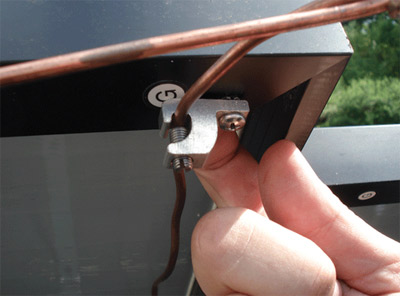
Photo 2. Example of proper bonding. You can see the whole is labeled for the function, the clamp is of stainless steel and the bushing digs into the metal for a good solid connection.
Mistakes and problems in PV applications can be costly and may not show up until well after the installation has been up and running, trouble free, for quite possibly years. The following is a brief overview of some key areas with which you will want to familiarize yourself for your next PV installation visit.
Bonding
PV presents some challenges when it comes to bonding; and the bonding / grounding of the system is very important — arguably the most important part of the installation. Most rails and frames of a PV system are anodized aluminum. If you use incorrect bonding practices or incorrect bonding materials, you may eventually achieve galvanic corrosion as shown in photo 1. The installation will look great when first installed but over time this bonding connection will be jeopardized and the impedance of the connection will increase, decreasing the effectiveness of your grounding system. The surface of these PV structures is non-conductive enough to prevent a good electrical connection with simple contact, but yet is not insulating enough to protect those who may touch it. Make sure you use the correct bonding lugs and read the instructions of every piece of equipment you install. The connection to panels is commonly done incorrectly in that the designated holes may not be used and new holes drilled and tapped for a volume of reasons. Take the time to observe bonding practices closely.
Apply Per Manufacturer’s Instructions
Reading user manuals and installation instructions are things we may not normally do when working with products with which we are familiar. PV and other dc applications may not be the environment that you are used to and, hence, this demands attention to detail. Read the instructions that come with all equipment; and if you are using accessories that did not come with the product, to which the accessory will be applied, make sure it is rated for it. You may consider creating a binder and collect user manuals and installation instructions for those systems you are visiting or may visit. This may become an invaluable resource. Grounding lugs and bonding equipment are common items that will be purchased separately and added to such equipment as various enclosures and solar panels. If you are not sure about the compatibility between these accessories and the products they will be installed in or on, call the manufacturer or the listing agent and make sure they are compatible.
Tapping
The point of connection to the ac system can lead one to make modifictions to existing equipment which voids the listing of the product. Tapping a bus in a switchboard or similar assembly should only happen if the bus you are tapping is labeled “TAP” or similar. This indicates that the holes you are about to use are meant for that purpose. There may be holes in the bus that if used but not labeled for tapping could void your UL listing. Discuss your modifications with the manufacturer. This includes any plans to add or integrate a PV system with an existing assembly, especially when it is not clear on how to do so.
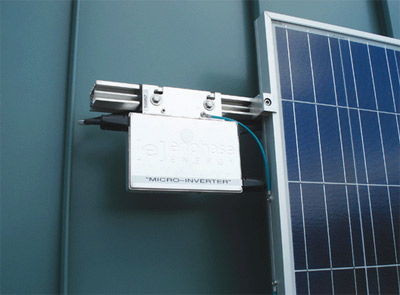
Photo 3. Example of a micro-inverter; these devices put ac on the roof instead of dc.
Reverse Feed Breakers
Another way to connect into the ac system for PV is through a breaker in an existing or new panel. Remember that some breakers may not be suitable for a reverse power feed application. If the breaker is labeled “Line” and “Load,” you cannot backfeed through this breaker. Only breakers that arenotlabeled “Line” and “Load” can be backfed. Nothing complicated to this fact; yet, we still find it in the field.
Readily Accessible
A PV system requires a readily accessible disconnect. Some utilities have special requirements of their own with this regard.Readily accessibleis defined in theNational Electrical Code(NEC) as “Capable of being reached quickly for operation, renewal, or inspections without requiring those to whom ready access is requisite to climb over or remove obstacles or to resort to portable ladders, and so forth.” In some cases, a dc disonnect may be located on the roof near the solar panels. There are even products on the market today that integrate the disconnect switch with the combiner box. If the disconnect is not in a readily accessible location, a separate dc disconnect that is readily accessible may be required. Some jurisdictions may require a dc disconnect on the roof next to the solar panels, but theCodeclearly states a dissconnect must be provided that is readily accessible.
The Combiner Box
This enclosure is known to be a source of many problems in PV systems. Some combiner boxes may be “home brewed” solutions and not listed. A combiner box may look simple, but make no mistake it should be a listed solution. Some combiner boxes require bonding bushings that can be found missing or installed incorrectly. The NEMA enclosure rating is also important for this and any enclosure used in a PV system. This is one common area for mistakes, mainly because of the environment. You are on a roof. Boxes mount easily when they are placed on their back. Make sure the NEMA rating permits this. You cannot put a 3R enclosure on its back on the roof — this application requires a 4R or higher enclosure. A 3R enclosure needs to be installed upright and not at an angle or flat on its back.
New Technologies
Everything is changing in these solar applications. A few examples include grounded versus ungrounded systems and micro-inverters. These are good examples because if you don’t know what you are walking into, you could be very much unprepared for what you see. Plan reviews are very important when it comes to spotting these anomalies. Ungrounded systems are going to be seen more and more in the United States. This is something that is very popular in other countries. This too may drive the voltages we work with up, and in some cases beyond what UL listings address to date. The isolation transformer found in grounded PV systems acts as a filter and a voltage changer among other things. When you remove the isolation transformer, an un-grounded PV system, you remove a lot of cost and inefficiencies from the system. You also remove the voltage changing capabilities and, hence, you may see voltages up to 1000 volts dc or even higher for these systems. Micro-inverters on the other hand will make you do a 180 as these devices put ac on the roof right after the panel. Your plan reviews are important.
Closing Remarks
If there is anything that you take away from this article on PV systems, I would hope that you understand that every PV job is a new experience. Your safety is paramount to anything else on the job site. Don’t assume anything is de-energized and don’t hurry through your work. The labeling requirements for PV systems alone should speak volumes. If you walk a code-compliant PV installation, the signs and labels alone are a sight to see. This alone should heighten your sense of awareness. But then again, the more you do, the more familiar you become and the more likely that a clumsy mistake may occur. Don’t let familiarity breed contempt when it comes to your next PV project.
As always, keep safety at the top of your list and ensure that you and those around you live to see another day. If you have any tips or ideas you would like to share, please feel free to send them to me at thomasadomitrovich@eaton.com. I look forward to your input to these articles and guidance for future articles.













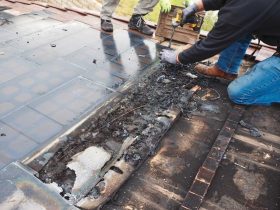
Find Us on Socials